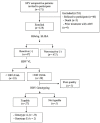HBV infection in untreated HIV-infected adults in Maputo, Mozambique
- PMID: 28759595
- PMCID: PMC5536281
- DOI: 10.1371/journal.pone.0181836
HBV infection in untreated HIV-infected adults in Maputo, Mozambique
Erratum in
-
Correction: HBV infection in untreated HIV-infected adults in Maputo, Mozambique.PLoS One. 2017 Dec 21;12(12):e0190460. doi: 10.1371/journal.pone.0190460. eCollection 2017. PLoS One. 2017. PMID: 29267379 Free PMC article.
Abstract
Background: HIV/ HBV coinfected patients are at high risk of developing chronic HBV infection, liver cirrhosis and hepatocellular carcinoma. In Mozambique, where HIV prevalence is one of the highest in the world, HIV-infected patients are scarcely characterized in terms of HBV coinfection and 3TC-resistance mutations profile.
Methods: To characterize ART-naïve HIV-infected adults, with and without HBV coinfection, a cross-sectional study was conducted between May and November 2012 in two health centers from Maputo city, Mozambique. Subjects were consecutively enrolled in the study and, then, tested for hepatitis B surface antigen (HBsAg). Moreover, CD4+ T cells count, HBV DNA in plasma, HBV genotyping and 3TC-resistance mutations profile of HBV were assessed in HIV/HBV coinfected patients.
Results: In total, 518 patients were enrolled in the study. The median age was 33 years old and 66.8% were women. The median CD4+ T cells count was 361 cells/mm3 and 47 (9.1%) were coinfected with HBV. Out of 46 coinfected patients, 24 (55.2%) had HBV DNA ≥ 20 - < 20 000 and 12 (26.1%) had HBV-DNA ≥20 000. APRI > 2.0 was reported in 4.3% of coinfected and 1.7% of monoinfected patients (p = 0.228), while FIB-4 > 3.25 was reported in 4.4% of coinfected and 1.3% of monoinfected patients (p = 0.112). Genotype A was the most frequent, identified in 25/27 (92.6%) patients, whereas genotype E was present in 2/27 (7.4%) patients. No patient had 3TC-resistance mutations.
Conclusions: This study showed that HBV coinfection was prevalent among ART-naïve HIV-infected adults in Mozambique. Overall, these data highlight the importance of screening HBV coinfection as an integrated measure of HIV routine care to improve health conditions and treatment of HIV/HBV coinfected patients.
Conflict of interest statement
Figures
References
-
- UNAIDS. AIDSInfo 2015 2015. Available from: http://aidsinfo.unaids.org/.
-
- Hoffmann CJ, Thio CL. Clinical implications of HIV and hepatitis B co-infection in Asia and Africa. Lancet Infect Dis. 2007;7(6):402–9. doi: 10.1016/S1473-3099(07)70135-4 . - DOI - PubMed
-
- Puoti M, Torti C, Bruno R, Filice G, Carosi G. Natural history of chronic hepatitis B in co-infected patients. J Hepatol. 2006;44(1 Suppl):S65–70. doi: 10.1016/j.jhep.2005.11.015 . - DOI - PubMed
-
- Alter MJ. Epidemiology of viral hepatitis and HIV co-infection. J Hepatol. 2006;44(1 Suppl):S6–9. doi: 10.1016/j.jhep.2005.11.004 . - DOI - PubMed
-
- Easterbrook P, Sands A, Harmanci H. Challenges and priorities in the management of HIV/HBV and HIV/HCV coinfection in resource-limited settings. Semin Liver Dis. 2012;32(2):147–57. doi: 10.1055/s-0032-1316476 . - DOI - PubMed
MeSH terms
Substances
LinkOut - more resources
Full Text Sources
Other Literature Sources
Medical
Research Materials


